Piyush M. Mehta
Laplacian-guided Entropy Model in Neural Codec with Blur-dissipated Synthesis
Mar 24, 2024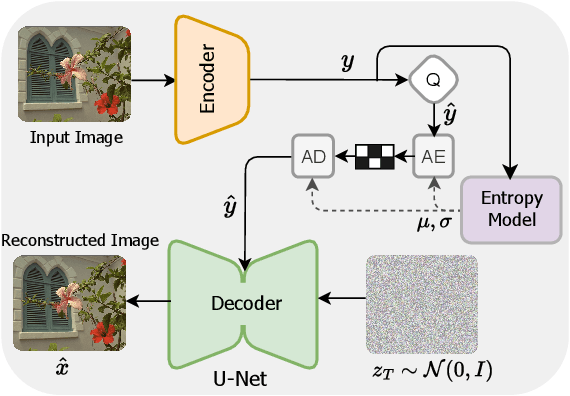
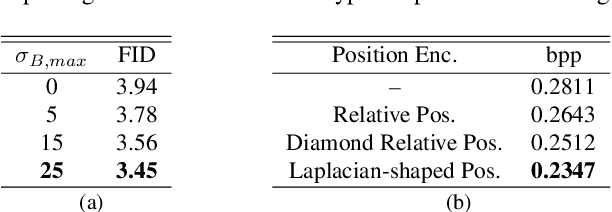
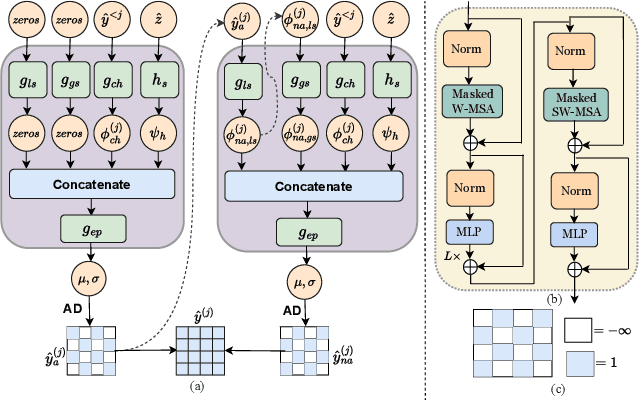
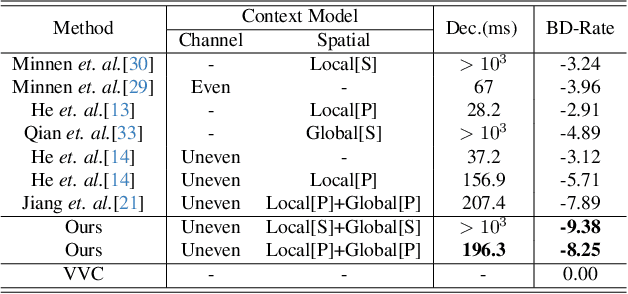
Abstract:While replacing Gaussian decoders with a conditional diffusion model enhances the perceptual quality of reconstructions in neural image compression, their lack of inductive bias for image data restricts their ability to achieve state-of-the-art perceptual levels. To address this limitation, we adopt a non-isotropic diffusion model at the decoder side. This model imposes an inductive bias aimed at distinguishing between frequency contents, thereby facilitating the generation of high-quality images. Moreover, our framework is equipped with a novel entropy model that accurately models the probability distribution of latent representation by exploiting spatio-channel correlations in latent space, while accelerating the entropy decoding step. This channel-wise entropy model leverages both local and global spatial contexts within each channel chunk. The global spatial context is built upon the Transformer, which is specifically designed for image compression tasks. The designed Transformer employs a Laplacian-shaped positional encoding, the learnable parameters of which are adaptively adjusted for each channel cluster. Our experiments demonstrate that our proposed framework yields better perceptual quality compared to cutting-edge generative-based codecs, and the proposed entropy model contributes to notable bitrate savings.
Neural-based Compression Scheme for Solar Image Data
Nov 06, 2023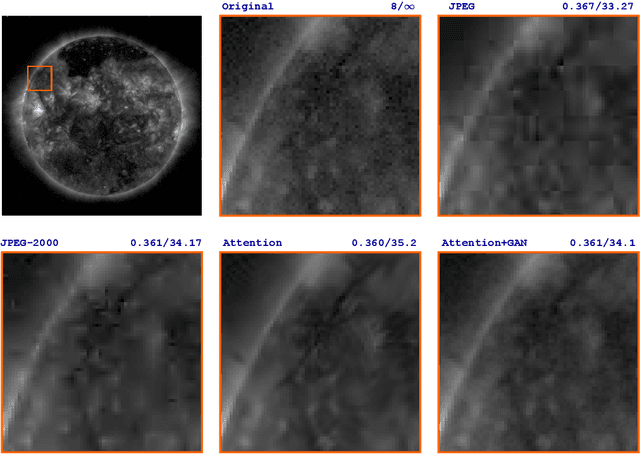

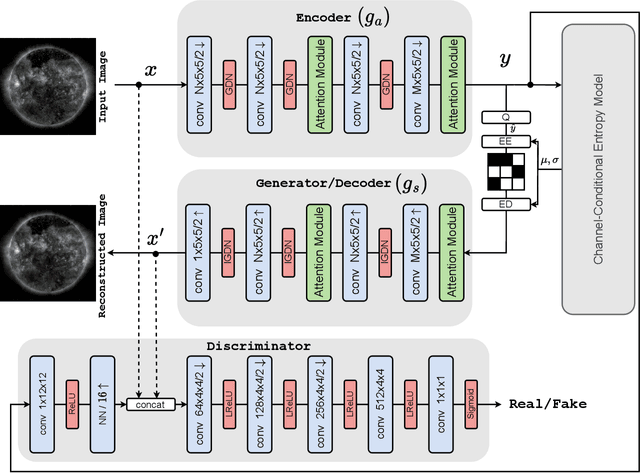
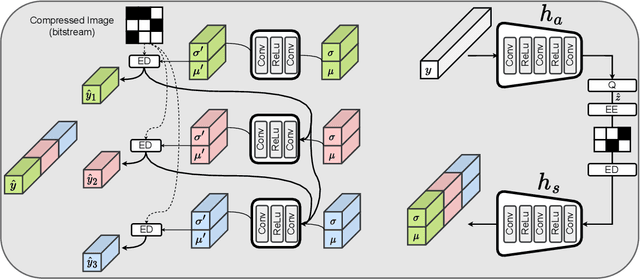
Abstract:Studying the solar system and especially the Sun relies on the data gathered daily from space missions. These missions are data-intensive and compressing this data to make them efficiently transferable to the ground station is a twofold decision to make. Stronger compression methods, by distorting the data, can increase data throughput at the cost of accuracy which could affect scientific analysis of the data. On the other hand, preserving subtle details in the compressed data requires a high amount of data to be transferred, reducing the desired gains from compression. In this work, we propose a neural network-based lossy compression method to be used in NASA's data-intensive imagery missions. We chose NASA's SDO mission which transmits 1.4 terabytes of data each day as a proof of concept for the proposed algorithm. In this work, we propose an adversarially trained neural network, equipped with local and non-local attention modules to capture both the local and global structure of the image resulting in a better trade-off in rate-distortion (RD) compared to conventional hand-engineered codecs. The RD variational autoencoder used in this work is jointly trained with a channel-dependent entropy model as a shared prior between the analysis and synthesis transforms to make the entropy coding of the latent code more effective. Our neural image compression algorithm outperforms currently-in-use and state-of-the-art codecs such as JPEG and JPEG-2000 in terms of the RD performance when compressing extreme-ultraviolet (EUV) data. As a proof of concept for use of this algorithm in SDO data analysis, we have performed coronal hole (CH) detection using our compressed images, and generated consistent segmentations, even at a compression rate of $\sim0.1$ bits per pixel (compared to 8 bits per pixel on the original data) using EUV data from SDO.
Multi-Context Dual Hyper-Prior Neural Image Compression
Sep 19, 2023

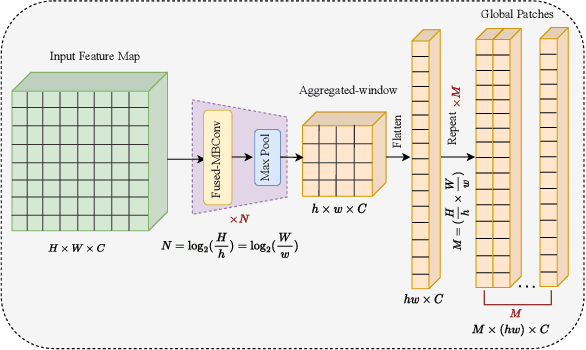
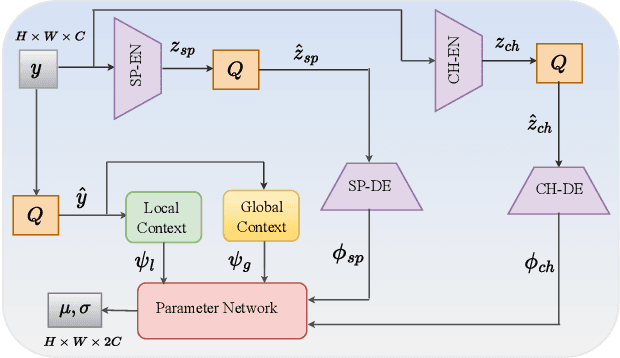
Abstract:Transform and entropy models are the two core components in deep image compression neural networks. Most existing learning-based image compression methods utilize convolutional-based transform, which lacks the ability to model long-range dependencies, primarily due to the limited receptive field of the convolution operation. To address this limitation, we propose a Transformer-based nonlinear transform. This transform has the remarkable ability to efficiently capture both local and global information from the input image, leading to a more decorrelated latent representation. In addition, we introduce a novel entropy model that incorporates two different hyperpriors to model cross-channel and spatial dependencies of the latent representation. To further improve the entropy model, we add a global context that leverages distant relationships to predict the current latent more accurately. This global context employs a causal attention mechanism to extract long-range information in a content-dependent manner. Our experiments show that our proposed framework performs better than the state-of-the-art methods in terms of rate-distortion performance.
Context-Aware Neural Video Compression on Solar Dynamics Observatory
Sep 19, 2023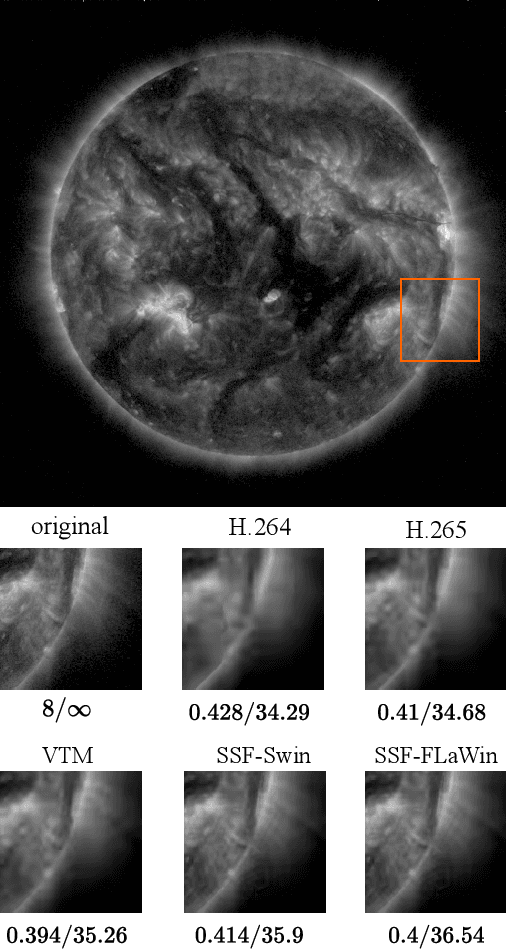
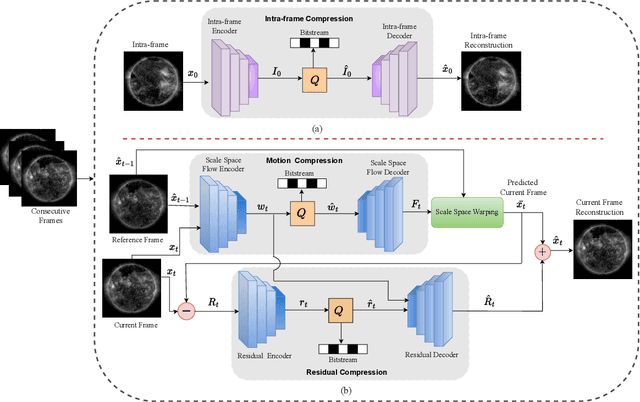
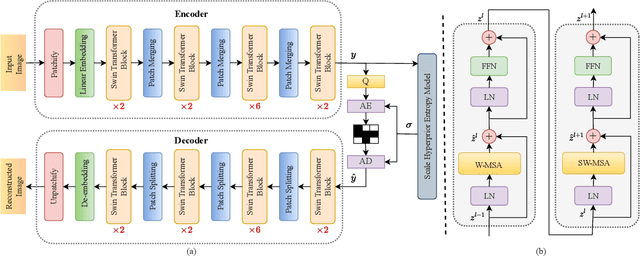
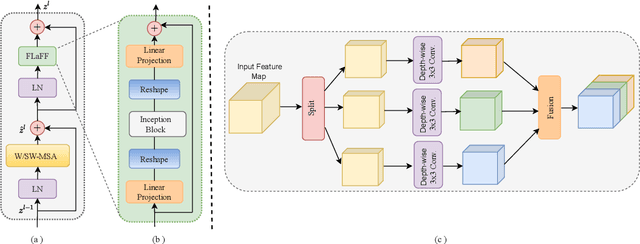
Abstract:NASA's Solar Dynamics Observatory (SDO) mission collects large data volumes of the Sun's daily activity. Data compression is crucial for space missions to reduce data storage and video bandwidth requirements by eliminating redundancies in the data. In this paper, we present a novel neural Transformer-based video compression approach specifically designed for the SDO images. Our primary objective is to efficiently exploit the temporal and spatial redundancies inherent in solar images to obtain a high compression ratio. Our proposed architecture benefits from a novel Transformer block called Fused Local-aware Window (FLaWin), which incorporates window-based self-attention modules and an efficient fused local-aware feed-forward (FLaFF) network. This architectural design allows us to simultaneously capture short-range and long-range information while facilitating the extraction of rich and diverse contextual representations. Moreover, this design choice results in reduced computational complexity. Experimental results demonstrate the significant contribution of the FLaWin Transformer block to the compression performance, outperforming conventional hand-engineered video codecs such as H.264 and H.265 in terms of rate-distortion trade-off.
Multi-spectral Entropy Constrained Neural Compression of Solar Imagery
Sep 19, 2023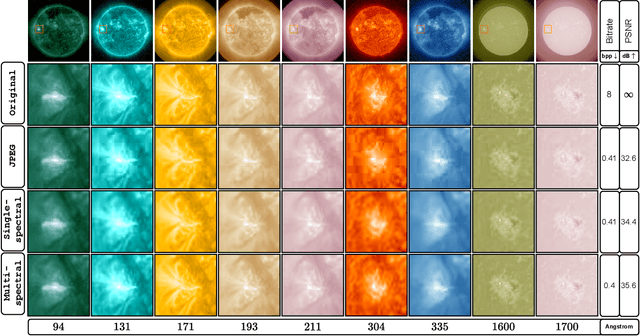

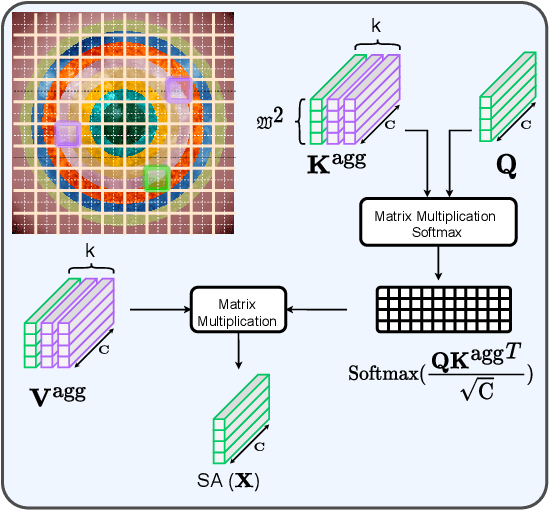
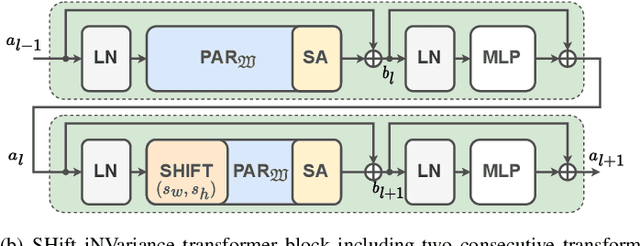
Abstract:Missions studying the dynamic behaviour of the Sun are defined to capture multi-spectral images of the sun and transmit them to the ground station in a daily basis. To make transmission efficient and feasible, image compression systems need to be exploited. Recently successful end-to-end optimized neural network-based image compression systems have shown great potential to be used in an ad-hoc manner. In this work we have proposed a transformer-based multi-spectral neural image compressor to efficiently capture redundancies both intra/inter-wavelength. To unleash the locality of window-based self attention mechanism, we propose an inter-window aggregated token multi head self attention. Additionally to make the neural compressor autoencoder shift invariant, a randomly shifted window attention mechanism is used which makes the transformer blocks insensitive to translations in their input domain. We demonstrate that the proposed approach not only outperforms the conventional compression algorithms but also it is able to better decorrelates images along the multiple wavelengths compared to single spectral compression.
Probabilistic Solar Proxy Forecasting with Neural Network Ensembles
Jun 03, 2023Abstract:Space weather indices are used commonly to drive forecasts of thermosphere density, which directly affects objects in low-Earth orbit (LEO) through atmospheric drag. One of the most commonly used space weather proxies, $F_{10.7 cm}$, correlates well with solar extreme ultra-violet (EUV) energy deposition into the thermosphere. Currently, the USAF contracts Space Environment Technologies (SET), which uses a linear algorithm to forecast $F_{10.7 cm}$. In this work, we introduce methods using neural network ensembles with multi-layer perceptrons (MLPs) and long-short term memory (LSTMs) to improve on the SET predictions. We make predictions only from historical $F_{10.7 cm}$ values, but also investigate data manipulation to improve forecasting. We investigate data manipulation methods (backwards averaging and lookback) as well as multi step and dynamic forecasting. This work shows an improvement over the baseline when using ensemble methods. The best models found in this work are ensemble approaches using multi step or a combination of multi step and dynamic predictions. Nearly all approaches offer an improvement, with the best models improving between 45 and 55\% on relative MSE. Other relative error metrics were shown to improve greatly when ensembles methods were used. We were also able to leverage the ensemble approach to provide a distribution of predicted values; allowing an investigation into forecast uncertainty. Our work found models that produced less biased predictions at elevated and high solar activity levels. Uncertainty was also investigated through the use of a calibration error score metric (CES), our best ensemble reached similar CES as other work.
Reduced Order Probabilistic Emulation for Physics-Based Thermosphere Models
Nov 09, 2022Abstract:The geospace environment is volatile and highly driven. Space weather has effects on Earth's magnetosphere that cause a dynamic and enigmatic response in the thermosphere, particularly on the evolution of neutral mass density. Many models exist that use space weather drivers to produce a density response, but these models are typically computationally expensive or inaccurate for certain space weather conditions. In response, this work aims to employ a probabilistic machine learning (ML) method to create an efficient surrogate for the Thermosphere Ionosphere Electrodynamics General Circulation Model (TIE-GCM), a physics-based thermosphere model. Our method leverages principal component analysis to reduce the dimensionality of TIE-GCM and recurrent neural networks to model the dynamic behavior of the thermosphere much quicker than the numerical model. The newly developed reduced order probabilistic emulator (ROPE) uses Long-Short Term Memory neural networks to perform time-series forecasting in the reduced state and provide distributions for future density. We show that across the available data, TIE-GCM ROPE has similar error to previous linear approaches while improving storm-time modeling. We also conduct a satellite propagation study for the significant November 2003 storm which shows that TIE-GCM ROPE can capture the position resulting from TIE-GCM density with < 5 km bias. Simultaneously, linear approaches provide point estimates that can result in biases of 7 - 18 km.
Attention-Based Generative Neural Image Compression on Solar Dynamics Observatory
Oct 12, 2022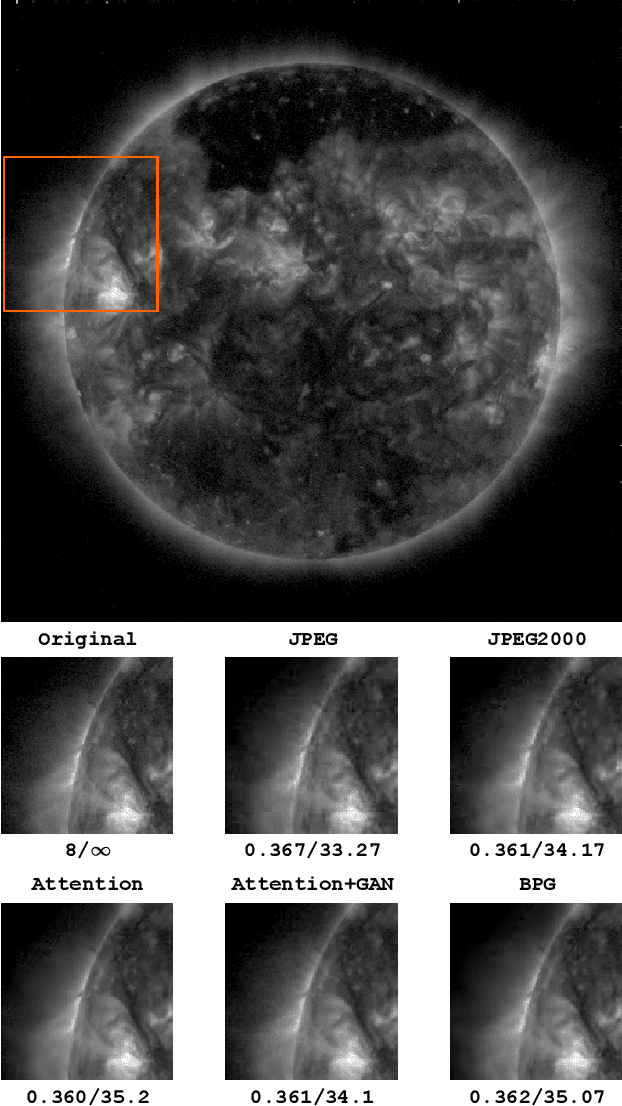
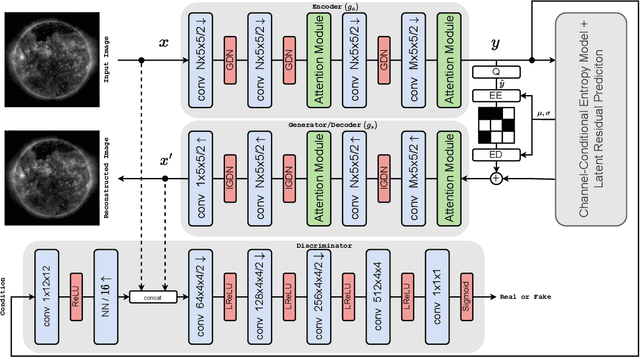
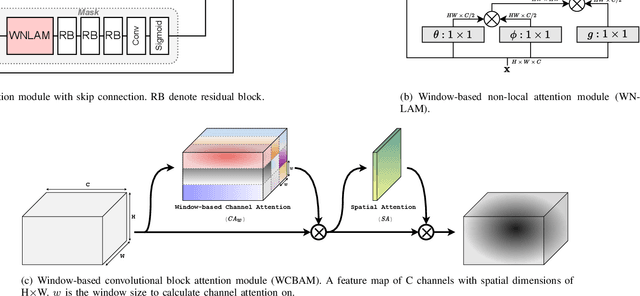

Abstract:NASA's Solar Dynamics Observatory (SDO) mission gathers 1.4 terabytes of data each day from its geosynchronous orbit in space. SDO data includes images of the Sun captured at different wavelengths, with the primary scientific goal of understanding the dynamic processes governing the Sun. Recently, end-to-end optimized artificial neural networks (ANN) have shown great potential in performing image compression. ANN-based compression schemes have outperformed conventional hand-engineered algorithms for lossy and lossless image compression. We have designed an ad-hoc ANN-based image compression scheme to reduce the amount of data needed to be stored and retrieved on space missions studying solar dynamics. In this work, we propose an attention module to make use of both local and non-local attention mechanisms in an adversarially trained neural image compression network. We have also demonstrated the superior perceptual quality of this neural image compressor. Our proposed algorithm for compressing images downloaded from the SDO spacecraft performs better in rate-distortion trade-off than the popular currently-in-use image compression codecs such as JPEG and JPEG2000. In addition we have shown that the proposed method outperforms state-of-the art lossy transform coding compression codec, i.e., BPG.
Calibrated and Enhanced NRLMSIS 2.0 Model with Uncertainty Quantification
Aug 24, 2022
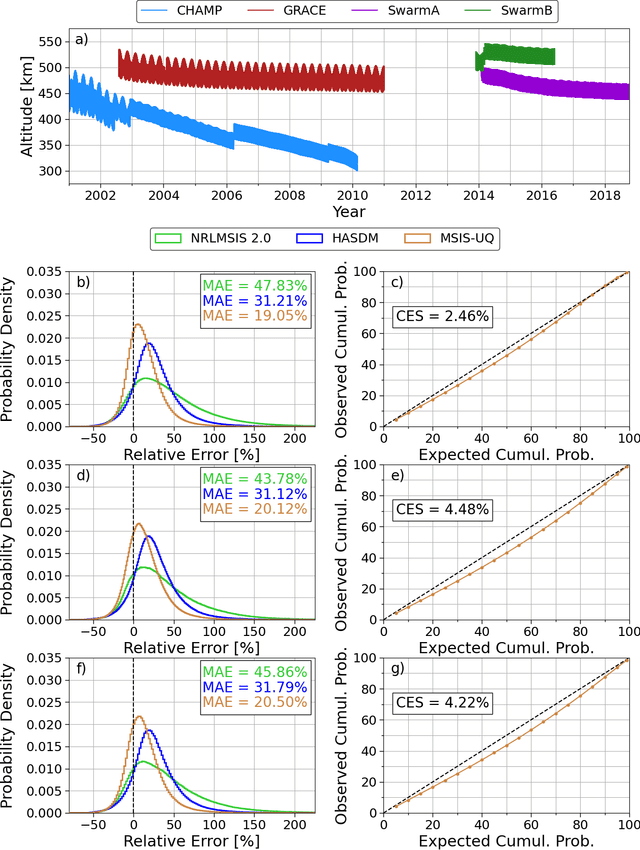

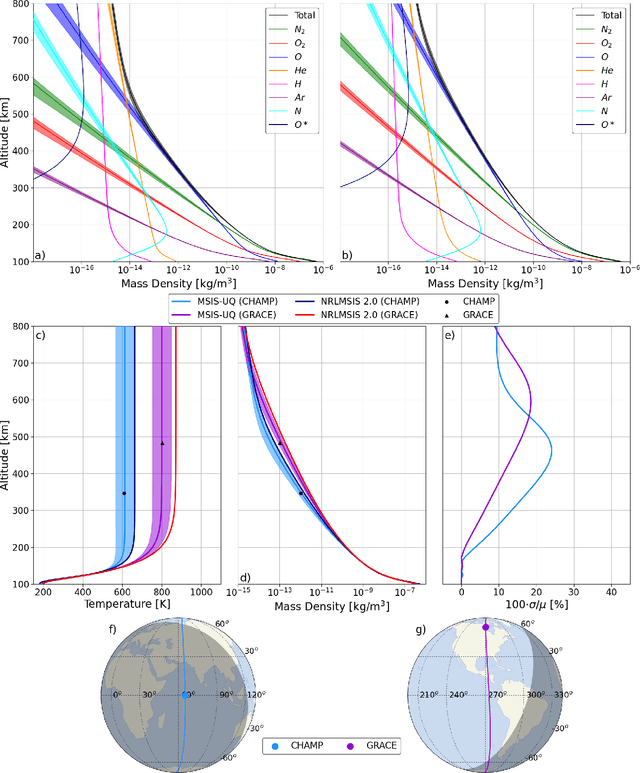
Abstract:The Mass Spectrometer and Incoherent Scatter radar (MSIS) model family has been developed and improved since the early 1970's. The most recent version of MSIS is the Naval Research Laboratory (NRL) MSIS 2.0 empirical atmospheric model. NRLMSIS 2.0 provides species density, mass density, and temperature estimates as function of location and space weather conditions. MSIS models have long been a popular choice of atmosphere model in the research and operations community alike, but - like many models - does not provide uncertainty estimates. In this work, we develop an exospheric temperature model based in machine learning (ML) that can be used with NRLMSIS 2.0 to calibrate it relative to high-fidelity satellite density estimates. Instead of providing point estimates, our model (called MSIS-UQ) outputs a distribution which is assessed using a metric called the calibration error score. We show that MSIS-UQ debiases NRLMSIS 2.0 resulting in reduced differences between model and satellite density of 25% and is 11% closer to satellite density than the Space Force's High Accuracy Satellite Drag Model. We also show the model's uncertainty estimation capabilities by generating altitude profiles for species density, mass density, and temperature. This explicitly demonstrates how exospheric temperature probabilities affect density and temperature profiles within NRLMSIS 2.0. Another study displays improved post-storm overcooling capabilities relative to NRLMSIS 2.0 alone, enhancing the phenomena that it can capture.
Science through Machine Learning: Quantification of Poststorm Thermospheric Cooling
Jun 12, 2022


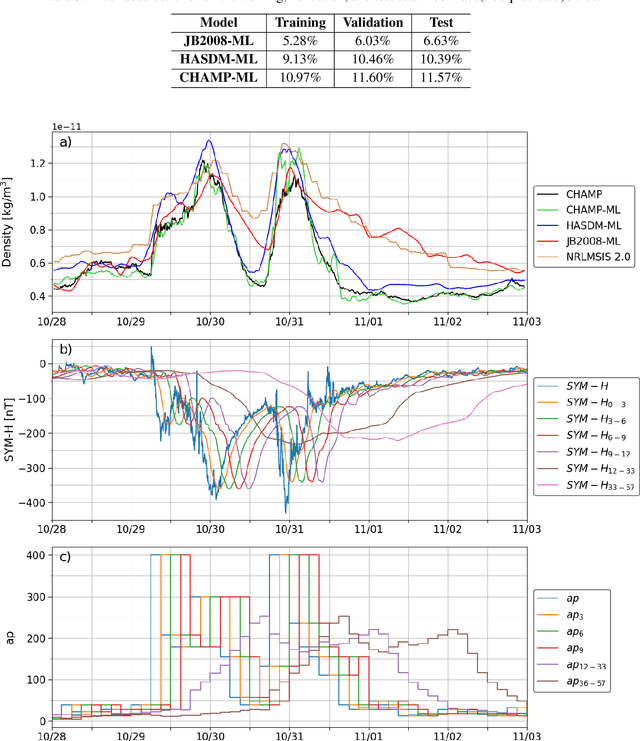
Abstract:Machine learning (ML) is often viewed as a black-box regression technique that is unable to provide considerable scientific insight. ML models are universal function approximators and - if used correctly - can provide scientific information related to the ground-truth dataset used for fitting. A benefit to ML over parametric models is that there are no predefined basis functions limiting the phenomena that can be modeled. In this work, we develop ML models on three datasets: the Space Environment Technologies (SET) High Accuracy Satellite Drag Model (HASDM) density database, a spatiotemporally matched dataset of outputs from the Jacchia-Bowman 2008 Empirical Thermospheric Density Model (JB2008), and an accelerometer-derived density dataset from CHAllenging Minisatellite Payload (CHAMP). These ML models are compared to the Naval Research Laboratory Mass Spectrometer and Incoherent Scatter radar (NRLMSIS 2.0) model to study the presence of post-storm cooling in the middle-thermosphere. We find that both NRLMSIS 2.0 and JB2008-ML do not account for post-storm cooling and consequently perform poorly in periods following strong geomagnetic storms (e.g. the 2003 Halloween storms). Conversely, HASDM-ML and CHAMP-ML do show evidence of post-storm cooling indicating that this phenomenon is present in the original datasets. Results show that density reductions up to 40% can occur 1--3 days post-storm depending on location and the strength of the storm.
 Add to Chrome
Add to Chrome Add to Firefox
Add to Firefox Add to Edge
Add to Edge